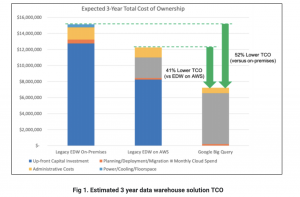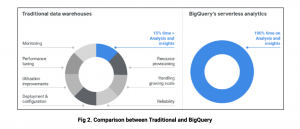Blog / The “Why” of Migrating your traditional data warehouse to Cloud
According to the IDC report, the global datasphere will grow from 33 zettabytes in 2018 to 175 zettabytes in 2025 which is a extremely huge spike.The true essence of digital transformation/digitization can only be achieved through cloud migration(both public and private).
Today, Data is at the heart of the digital transformation and is the new Oil for serving the customers in a profound way. Companies/Enterprises are leveraging data to improve a lot in different ways such as customer experiences, open new markets, making employees and processes more productive, and creating new sources of competitive advantage – quintessentially working towards the future of tomorrow.
Let’s try to understand the fundamentals of data warehouse, challenges associated with traditional data warehouses and benefits of migrating to Cloud and last, why to choose Google Cloud’s BigQuery.
Data Warehouse
- A data warehouse consolidates business data from in-house applications, databases and SaaS(Software as a Service) platforms which serves as a single central repository that an Organization can consult to make decisions with analytics and business intelligence tools.
- The process of design and implementation involve Immense Undertaking and a great deal of planning, collaboration, and coordination of People, Resources, and Time.
The Challenges associated with traditional data warehousing are :
Data Quality
- In a Data Warehouse, data is coming from multiple sources within an organization. Data Warehouses that include Inconsistent data will encounter errors, inconsistency, duplicates, and missing data, all of which results in data quality issues.
- These data quality challenges can result in faulty Reporting and Analytics necessary for optimal decision-making.
Inflexible Structure
A lack of flexibility has always been one of the most apparent faults in traditional data warehousing. Today, Organizations have a huge amount of incoming Structured(tabular) and unstructured data(images,audio, videos) coming from multiple sources like web,mobile and IoT applications which takes extra resource setup and a good amount of time making the whole process cumbersome and inefficient.
Complex Architecture
- To meet ever-evolving requirements, Organizations purchase add-on solutions ,creating a complex environment of numerous data layers.Each of these requires constant management and regular updates to ensure accuracy and consistency of the data warehouse.
- One of the problems of having different solutions/technologies is lack of Integration options among them.
Slow Performance
- Today’s businesses are generating and gaining access to far more information than in previous years- and the volumes are growing exponentially. An overload of data can affect a platform’s performance and cause delays in reporting.
- At the same time, users increasingly expect on-demand access to information,meaning it becomes more crucial than ever to avoid interruptions(downtime) to normal service.This decreases the traditional data warehouses performance over time.
Total Cost Ownership (TCO)
- Total cost ownership is the total cost of a product including procurement,Operations and management.
- According to this survey, Google Cloud BigQuery(a product for data warehouse) lowers the TCO by 52% when compared to the on-premises data warehouse solutions.

Do You Know
- The public cloud service market is expected to reach $623 billion by 2023 worldwide.
- By 2022, 75% of all databases will be deployed or migrated to a cloud platform, with only 5% ever considered for repatriation to on-premises.
Benefits of Migrating to Cloud
On-demand scalability
- Cloud offers on-demand scalability which means you can easily scale up and down to store and analyze petabytes to exabytes of data with ease.
- The end user gets the default setup of resources, networking and data securities and can be also deeply customized as per the requirement.
Cost efficiency
- With on-demand scalability, you will only be billed when resources are being utilized according to the requirements.
- It does not matter if the requirements come during the day, night, weekdays or weekends, the resources can be utilized at any time and corresponding cost is incurred.
Bundled capabilities such as IAM,Data Governance and Analytics
- Cloud IAM (Identity and Access Management) lets administrators authorize who can take what action on which specific resources(products),giving the user full control and visibility to manage Cloud resources.
- It also provides strong security and governance with fine-grained controls.
- The data is highly available(very low latency when accessing the data) and can be easily integrated with different visualisation tools to analyse,assess and understand the value/patterns hidden inside the data.
- This highly available data,analysis reports/dashboards,business logic can be shared in near real-time with the individual departments such as marketing,finance,sales,etc.
- It provides flexibility to rapidly build prototype applications based on new business logic/customer Insights without considering the limitation of hardware requirement. The data can be accessed and transformed in near real-time and end users can directly visualise the Insights and make decisions constructively.
Why you should migrate your traditional Data Warehouse to Google Cloud Platform’s BigQuery
BigQuery
BigQuery is a Serverless enterprise data warehouse that solves the problem of Storing and Querying massive datasets(upto exabytes of data) by enabling super-fast SQL queries using the processing power of Google’s Infrastructure. With serverless data warehousing, Google does all the resource provisioning behind the scenes, hence users can focus on Data and Analysis rather than worrying about upgrading,securing or managing the data warehouse infrastructure.

Features of BigQuery
Data Warehouse Migration
- BigQuery Data Transfer Service : It automates the ingestion of data from multiple sources such as Google Ads, YouTube,Google Cloud Storage,Amazon S3, etc into BigQuery. The developers can initially start this process without writing a single line of code.
- Multiple business SaaS applications data can also be moved into BigQuery easily on a scheduled regular basis using different integration tools such as Cloud Data Fusion, Informatica, Talend,etc.
- BigQuery Omni lets us securely access and analyse exabytes of data on multi-cloud platforms such as AWS and Azure using the same UI of BigQuery.
Eliminating the Migration Risks and Security challenges
As already mentioned, It’s difficult to scale up (availability of resources with increased requirements) as well as maintain data security in the traditional data warehouses.BigQuery has couple of built-in features to handle this :
- Cloud Identity and Access Management(IAM) is key to setting appropriate role-based user access to make sure right(desired) people are able to view/edit/delete the multiple datasets in BigQuery.
- Users can also define their own Encryption keys for their datasets using customer managed encryption keys which gives even tighter security.
Speed and Performance
- Managing a traditional data warehouse isn’t usually synonymous with speed. Performance often comes at the cost of compute and storage, so users can’t do the analysis they need until other queries have finished running.
- Reporting and other analytics functions may take hours or days, which is especially true when a lot of data is available, like an end-of-quarter sales calculation. As the amount of data and number of users rapidly grows, performance begins to melt down(scalability problems arise) and organizations often face challenges.
- However, with BigQuery, compute(CPU,RAM) and storage(HDD, SDD,Persistent disks) are decoupled(separated), so you can scale immediately without facing Infrastructure constraints.
- BigQuery helps modernize because it uses a familiar SQL interface, so users can run queries in seconds and share insights right away.
Real-time Analytics
- BigQuery’s high-speed streaming insertion API provides a powerful foundation for real-time analytics, making the latest business data immediately available for analysis.
- Machine Learning models can be easily built using BigQuery ML with the same SQL syntax without the overhead on users of learning the whole ML workflow.
- BigQuery provides integration with the Apache big data ecosystem, allowing existing Hadoop/Spark and Beam workloads to read or write data directly from BigQuery leveraging Google Dataproc.
Enterprise businesses are absolutely going to observe the benefits of the Cloud and its Infrastructure,networking and Security aspects as the data is the new Oil and they want to understand the hidden values inside their huge data along with a cost Optimized solution which Cloud absolutely offers when compared with Traditional data warehouses.
Here is an example of an organization that migrated their warehouse and reduced eight-hour workloads to five minutes using Google Cloud BigQuery.
References:
1. https://cloud.google.com/blog/products/data-analytics/5-reasons-your-legacy-data-warehouse-wont-cut-it
2. https://cloud.google.com/bigquery
3. https://www.gartner.com/en/newsroom/press-releases/2019-07-01-gartner-says-the-future-of-the-database-market-is-the
4. https://www.esg-global.com/hubfs/pdf/ESG-Economic-Validation-Migrating-to-Google-BigQuery-for-EDW.pdf?hsCtaTracking=c72c8cf5-f49c-4acc-bc13-8075c2f2c36d%7C58132319-a125-437c-bd19-2dd33e2e3ec9
5. https://www.prnewswire.com/news-releases/623-bn-cloud-computing-market—global-forecast-to-2023-increase-in-adoption-of-hybrid-cloud-services-300820321.html



